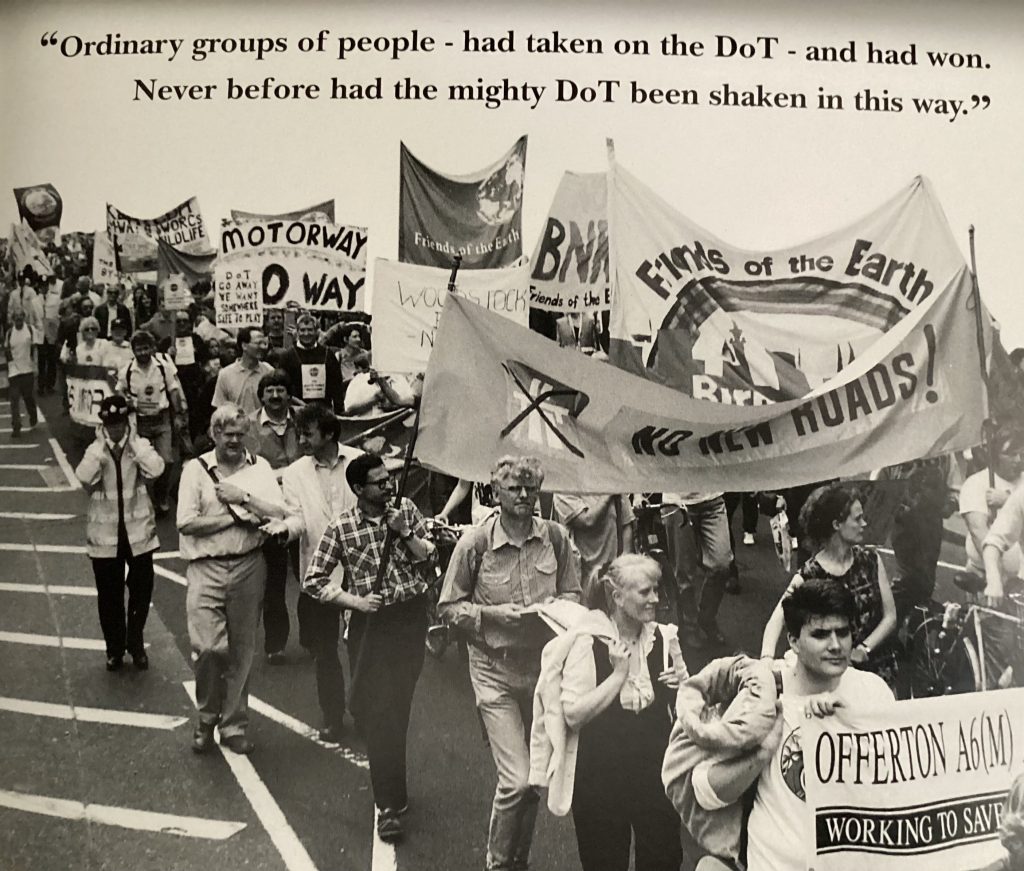Stopping a roads programme
I was one of the founders and coordinators of ALARM UK – a successful national coalition of anti-road protest groups in the 1990s. Here’s an extract from ‘Road Block – how people power is wrecking the roads programme’ which told the story of the campaign. The full text of the booklet can be downloaded here
“The question is simple,” said Rupert Harwood, one of the founders of ALARM UK, “can we reproduce the ALARM campaign across the country? If so, the Government’s National Roads Programme would be in severe trouble. ” He was speaking in 1991 to Jonathan Bray, Gina Harkell and John Stewart. Together, round a kitchen table, they formed ALARM UK.
Each person had played an important role in ALARM. Now they set out to employ the strategy they had used in London to take on something much bigger – the £23 billion National Roads Programme. The DoT had unveiled it in 1989 with bravado, boasting that it was the biggest road-building programme undertaken in Britain ‘since the Romans’.
The DoT had not been put off by what happened in London. It put its defeat over the Assessment Studies down to London being a special case. Nationally, it intended to spend £13 billion over ten years to substantially ‘upgrade’ the country’s road system. This was later revised upwards to £23 billion. There were two main reasons for this massive proposed expenditure: the government was concerned that the country’s road infrastructure would not meet the demands of a Single European Market; and it also looked with alarm at the way, traffic was predicted to grow – between 83% and 142% by the year 2025. The scale of the programme was awesome. Huge swathes of the motorway and A-road network were to be widened and rebuilt. The country was to be transformed, with the motorwav network widened to ten, twelve or even fourteen lanes. New motorway boxes were proposed for regions like the West Midlands and Greater Manchester, plus new quasi-motorways like the South Coast Expressway and the Home Counties East-West route. According to English Nature, 161 Sites of Special Scientific Interest were threatened (SSSIs represent the UK’s best areas for flora, fauna & geology), while English Heritage calculated that over 800 important archeological sites could be affected. A survey of the South East found that over 370 wildlife sites were threatened by, national or local road schemes. For the powerful road lobby, the 1989 roads programme represented their finest hour. With such a vast increase in road- building, rocketing car use (during the 1980s, traffic doubled on the motorway network) and declining public transport, the future looked bleak from the point of view of campaigners. On the plus-side, the scale of the roads programme was such that the scale of potential opposition was equally vast, especially when the road-planning process was so skewed against objectors that it was capable of radicalising the most conventional of citizens.
Around that kitchen table, ALARM UK devised its strategy Essentially, it followed the London pattern to provide: a central, umbrella organisation which supplied local groups with information on transport, environmental and campaigning matters, which staged occasional nationwide stunts (including a ‘Stop That Road Week’) and which held conferences where the groups could meet. ALARM UK groups would be autonomous. ALARM UK has never had a constitution, just a set of guiding principles. The idea was never to build up ALARM UK for its own sake, but simply to establish a movement to create a climate of protest which would overcome the National Roads Programme and so pave the way for real investment in more sustainable forms of transport.
For the full story follow this click here
